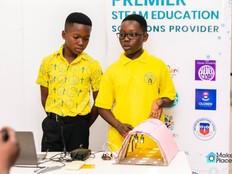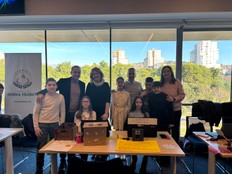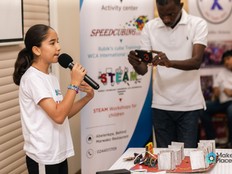Our project
The students designed their project using a network of Microbit devices connected in a circuit that allows electricity to flow through. The last Microbit in the circuit signals whether the soil is sufficiently moist. In their prototype, they used nails in the soil to create this connection, but in a larger-scale system, steel structures would be used to conduct electricity through the ground. It’s important to note that electricity flows from the positive to the negative end in this type of setup.
The reason the students didn’t just rely on a single Microbit is that they wanted to focus on measuring soil moisture at different depths. Microbit devices are ideal for this purpose because they can monitor moisture levels in the soil over varying depths. The idea is that, if the soil is moist enough at the correct depth, the system can keep the irrigation running and prevent fire risks by ensuring the ground stays wet.
Another crucial factor here is that water and salt are both conductors of electricity. Since soil naturally contains moisture, this allows the current to travel through the nails embedded in the ground, completing the circuit. When the soil reaches a certain level of moisture, the system signals that the conditions are right for the irrigation to continue working.
To ensure the system works efficiently over longer distances, multiple Microbit devices are used to form a larger circuit. This is important because voltage tends to drop over long distances of wiring. By using several devices, the system ensures that the signal remains strong enough to detect soil moisture, even across large areas. The devices are connected in series to maintain consistent voltage throughout the entire circuit.
Additionally, each Microbit in the system is designed to send an extra 3V through the soil. This ensures that even small moisture levels can be detected because the 3V needs to find a path through the soil to complete the circuit. When combined with OUT 2, this extra voltage improves the system's responsiveness and accuracy. While this additional 3V may not be necessary for smaller areas where the moisture level is easier to detect, it is vital for larger areas where the moisture distribution can be more uneven.
The students designed their project using a network of micro:bit devices connected in a circuit that allows electricity to flow through. The last micro:bit in the circuit signals whether the soil is sufficiently moist. In their prototype, they used nails in the soil to create this connection, but in a larger-scale system, steel structures would be used to conduct electricity through the ground. It’s important to note that electricity flows from the positive to the negative end in this type of setup.
The reason the students didn’t just rely on a single micro:bit is that they wanted to focus on measuring soil moisture at different depths. micro:bit devices are ideal for this purpose because they can monitor moisture levels in the soil over varying depths. The idea is that, if the soil is moist enough at the correct depth, the system can keep the irrigation running and prevent fire risks by ensuring the ground stays wet.
Another crucial factor here is that water and salt are both conductors of electricity. Since soil naturally contains moisture, this allows the current to travel through the nails embedded in the ground, completing the circuit. When the soil reaches a certain level of moisture, the system signals that the conditions are right for the irrigation to continue working.
To ensure the system works efficiently over longer distances, multiple micro:bit devices are used to form a larger circuit. This is important because voltage tends to drop over long distances of wiring. By using several devices, the system ensures that the signal remains strong enough to detect soil moisture, even across large areas. The devices are connected in series to maintain consistent voltage throughout the entire circuit.
Additionally, each micro:bit in the system is designed to send an extra 3V through the soil. This ensures that even small moisture levels can be detected because the 3V needs to find a path through the soil to complete the circuit. When combined with OUT 2, this extra voltage improves the system's responsiveness and accuracy. While this additional 3V may not be necessary for smaller areas where the moisture level is easier to detect, it is vital for larger areas where the moisture distribution can be more uneven.
This innovative approach shows how the students carefully considered both the technical and practical aspects of the system. They've created a solution that not only addresses the immediate concern of fire prevention but also ensures the system can work efficiently across a larger area. Their focus on using technology to help the community and protect the environment is impressive, and the project reflects their understanding of how technology can be applied in meaningful ways to solve real-world problems.
Our inspiration
The students came together around a shared idea, motivated by a desire to actively participate and contribute something meaningful to their community. Through this project, they aimed to tackle a real problem – the frequent wildfires caused by citizens' negligence, which pose a threat to lives and property, especially in remote areas. Many of the students have grandparents living in rural areas that are often at risk of wildfires, which sparked a strong desire in them to create a solution to protect these areas.
Their motivation was clear – to help protect the elderly, their homes, and their land from natural disasters, particularly wildfires. By using innovative technologies like Microbit devices, the students developed a system that can detect soil moisture, automatically activate irrigation, and thus prevent the spread of fire during dry periods. In doing so, they are not only contributing to environmental preservation but also actively solving a serious ecological problem facing their community.
This project is more than just a technical solution – it reflects a genuine wish to take concrete steps in protecting people in remote, often neglected areas. The students put in significant effort to develop a functional, efficient, and sustainable system, using the technology available to them. Their work demonstrates how important it is to use technological innovations in the right way to improve safety and quality of life, especially in rural and underserved areas.
Their goal is clear – to create a solution that will not only help their grandparents but can also be applied to a wider region, with the potential to raise awareness about fire prevention at all levels.





